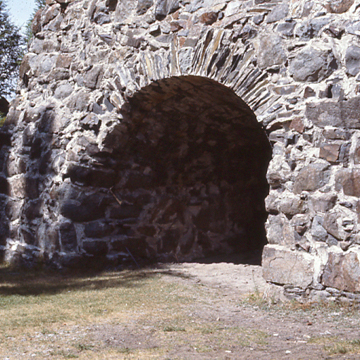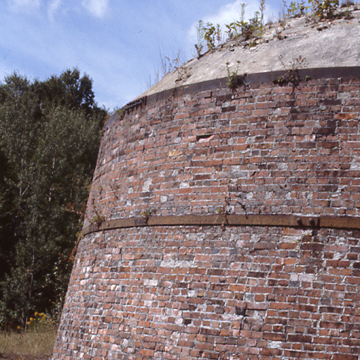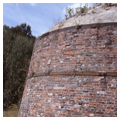Located near Dover-Foxcroft in Piscataquis County, the beehive oven and blast furnace tower of the Kathadin Iron Works stand as significant artifacts of the once important antebellum Maine iron industry. Unlike most Maine foundries, which re-melted imported pig iron in casting furnaces for use in manufacturing agricultural tools, stoves, or locomotives, the Kathadin Iron Works produced iron from local bog ore.
In 1843 Moses Greenleaf discovered iron ore deposits (surface limonite gossan) on what came to be known as Ore Mountain near Dover-Foxcroft. Kathadin Iron Works was incorporated in 1845. A company town quickly grew along the road built to access the site; it included a boarding house for 200 men, a company store, post office, and town hall. A 55-foot-high blast furnace was also built, which helped the company produce up to 2,000 tons of raw iron annually (with the exception of the years 1858–1863). Charcoal-fueled, Kathadin’s furnaces annually consumed between 10,000 and 14,000 cords of wood. After 1882, cordwood was conveyed to the remote iron works via the Bangor and Kathadin Iron Railroad, called the Black Maria. Sixteen beehive ovens at the site converted the wood into charcoal. From what was once a sizeable industrial establishment only a single beehive oven and one blast furnace remain. Both the beehive-shaped oven and the clipped pyramid-shaped furnace are made of stone with frontal openings. The furnace has a brick chimney (or tower) erupting from the pyramid.
Kathadin employed between 200 and 400 workers in the years 1873–1890. Although located close to the North Woods and Maine’s timber industry, the works did not produce ax heads or other locally useful products. Instead, it shipped its raw iron out of the state for use in the production of wire and railroad car wheels. Kathadin Works ceased operation in 1890, due to the rising cost of kiln wood, the opening of the Mesabi Iron Range in Minnesota, and competition from giant iron and steel mills in Pennsylvania.
Since 1965, the parklike, 17.8-acre industrial site has been owned and operated by the Maine Bureau of Parks and Recreation. The furnace and beehive oven were restored in 1966 by Roland Robbins, who also worked on the Massachusetts Saugus Iron Furnace. The site is open to the public.
References
Eastman, Joel W, and Paul E. Rivard. “Transportation and Manufacturing.” In Maine: The Pine Tree State from Prehistory to the Present, edited by Richard W. Judd, Edwin A. Churchill, and Joel W. Eastman .Orono: University of Maine Press, 1995.








